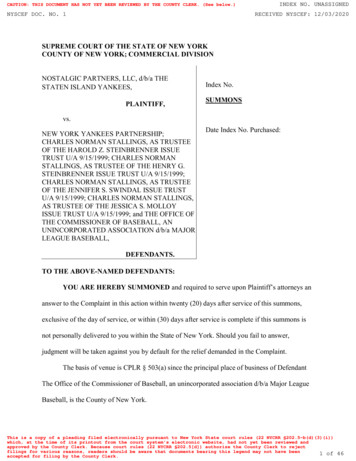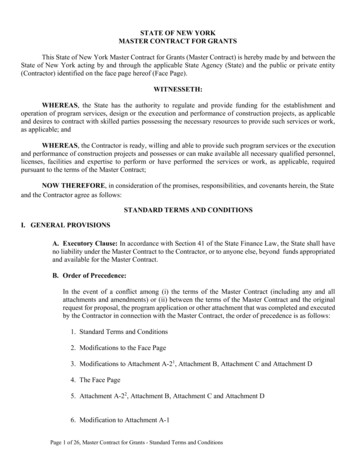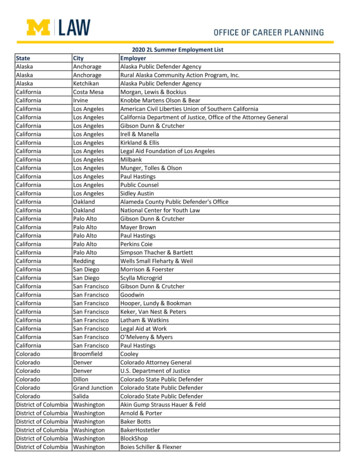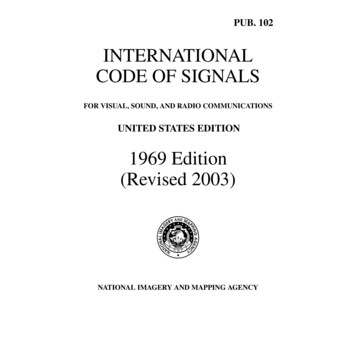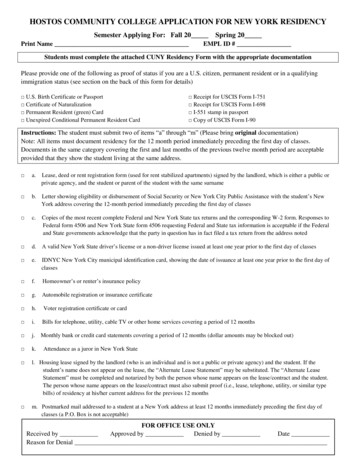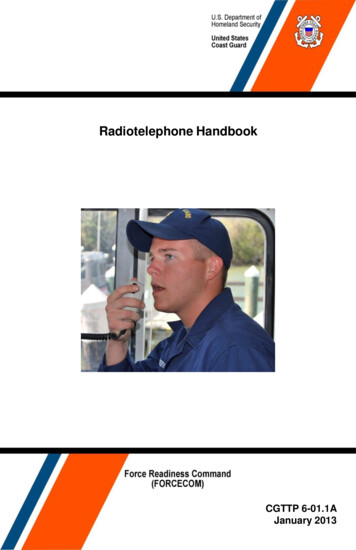
Transcription
Radiotelephone HandbookCGTTP 6-01.1AJanuary 2013
This page intentionally left blank.
CommanderUnited States Coast GuardForce Readiness Command300 E. Main Street,Suite 1100Norfolk, VA 23510Staff Symbol: FC-PPhone: (757) 628-4463CGTTP 6-01.1A16 JAN 2013COAST GUARD TACTICS, TECHNIQUES, AND PROCEDURES6-01.1ASubj:RADIOTELEPHONE HANDBOOKRef:(a) Communication Instructions Radiotelephone Procedures,Allied Communications Publication (ACP) 125 (series)(b) Naval Communications, Naval TelecommunicationsProcedures (NTP) 4 (series)(c) International Telecommunication Union (ITU) RadioRegulations (series)(d) Telecommunication Manual, COMDTINST M2000.3(series)(e) U.S. Coast Guard Addendum to the United States NationalSearch and Rescue Supplement (NSS) to the InternationalAeronautical and Maritime Search and Rescue Manual(IAMSAR), COMDTINST M16130.2 (series)1.PURPOSE. To provide communications personnel with Coast Guardtactics, techniques, and procedures (CGTTP) for using theradiotelephone.2.ACTION. The provisions of this CGTTP apply to all Coast Guardpersonnel conducting voice telecommunications by radiotelephone.Internet release is authorized.3.DIRECTIVES/TTP AFFECTED. This publication supersedes theRadiotelephone Handbook, CGTTP 6-01.1.4.DISCUSSION. The Radiotelephone Handbook is a user’s guideaddressing proper radiotelephone procedures. It consolidates portionsof International Telecommunication Union (ITU) radio regulations andvarious allied communications publications (ACPs) into a single sourcereference for field use.
CGTTP 6-01.1ARadiotelephone Handbook5.MAJOR CHANGES. This revision includes clarification regarding useof the term “MAYDAY” during distress communications, provides anexample of a “MAYDAY RELAY” transmission, and also specifieswhen and how to include maritime mobile service identity (MMSI)information. This revision includes the following changes:a.In Section 8: Distress, Urgent, and Safety Communications:1.) 8.a. Distress Communications, revised and added new text in#4 and #5.2.) 8.a.1 Receipt of Distress Messages, revised text in #1, #5, andthe note after #9.3.) 8.a.2. MAYDAY Relay Procedures, revised and added newtext in #6 and #7.4.) 8.a.4. Imposing Radio Silence during SAR Operations, deletedthe note.5.) 8.b.1. Urgent Message Details, amended text in the preliminaryannouncement and message text.6.) 8.b.2. Cancellation of Urgent Message, revised the example.7. ) 8.c. Safety Communications, revised the preliminaryannouncement and message text.b.6.In Appendix A: Glossary and Acronyms, added an entry for“MMSI.”PROCEDURE. An electronic version of this publication will be postedin the Coast Guard TTP library EQUEST FOR CHANGES. Submit recommendations for TTPimprovements or corrections by e-mail to:FORCECOM-PI@uscg.milInfo COMCOGARD FORCECOM NORFOLK VA//FC-P// onmessage traffic containing lessons learned applicable to this TTP.
CGTTP 6-01.1ARadiotelephone Handbook8.RECORDS MANAGEMENT CONSIDERATIONS. This publicationhas been thoroughly reviewed during the TTP coordinated approvalprocess. It has been determined there are no further records schedulingrequirements in accordance with Federal Records Act, 44 U.S.C. 3101et seq., NARA requirements, and Information and Life CycleManagement Manual, COMDTINST M5212.12 (series). Thispublication does not have any significant or substantial change toexisting records management requirements.9.ENVIRONMENTAL ASPECT AND IMPACT CONSIDERATIONS.Environmental considerations under the National Environmental PolicyAct (NEPA) were examined in the development of this document andhave been determined to not be applicable.10. FORMS/REPORTS. None.WOLTER.WILLIAM.J.1137530267Digitally signed by WOLTER.WILLIAM.J.1137530267DN: c US, o U.S. Government,ou DoD, ou PKI, ou USCG,cn WOLTER.WILLIAM.J.1137530267Date: 2013.01.17 09:42:28 -05'00'WILLIAM J. WOLTERCaptain, U. S. Coast GuardChief, FORCECOM TTP Division (FC-P)By Direction of Commander,Force Readiness Command
CGTTP 6-01.1ARadiotelephone HandbookThis page intentionally left blank.
Table of Contents1. Introduction. 12. Notes, Cautions, Warnings . 13. Basic Operating Rules . 14. Message Fundamentals . 105. BEADWINDOW Procedures . 126. Radio Checks. 127. Radio Silence on Directed Nets . 148. Distress, Urgent, and Safety Communications . 14Appendix A: Glossary & Acronyms.A-1Appendix B: Authorized Procedure Words (Prowords) . B-1Appendix C: Essential Elements of Friendly Information (EEFIs) . C-1Appendix D: Common Frequencies . D-1Index . I-1i
This page intentionally left blank.ii
CGTTP 6-01.1ARadiotelephone Handbook1. IntroductionThis handbook gives general, unclassified radiotelephonetactics, techniques, and procedures (TTP) for U.S. CoastGuard (USCG) use. See reference (a) for tactical militaryprocedures.Radiotelephone is telecommunication by voice radio. It isone of the most common forms of communication betweenUSCG, federal, state, and local authorities and the maritimepublic.Appendix A has a list of common radiotelephone terms anddefinitions.The maritime public might not understand strict militaryprocedures, so you might have to use internationalradiotelephone procedures when communicating with nonmilitary vessels or aircraft.2. Notes,Cautions,WarningsNOTE:The following definitions apply to notes, cautions, andwarnings found in this TTP.An emphasized statement, procedure, or technique.CAUTION:A procedure, technique, or action which, if notfollowed, carries the risk of equipment damage.WARNING:A procedure, technique, or action which, if notfollowed, carries the risk of injury or loss of life.3. BasicOperatingRulesRadiotelephone users speak for, and with the authority of,their command. Always follow established procedures tomaintain circuit discipline. Sectors and communicationstations monitor radiotelephone circuits to ensurecompliance with professional standards.1
CGTTP 6-01.1ARadiotelephone Handbook3.a. ProhibitedPractices3.b. Operatingthe Radiotelephone SetReference (a) prohibits the following radiotelephonepractices: Violating radio silence. Unofficial conversation between operators. Transmitting on a directed net without permission(except for flash or immediate precedence traffic). Excessive tuning or testing for more than 10 seconds. Failure to listen before transmitting. Transmitting the operator’s personal sign or name. Using other than authorized procedure words(prowords). (Appendix B of this handbook is a quickreference guide). Unauthorized use of plain language in place ofapplicable prowords or operating signals (OPSIGs). Any other unauthorized use of plain language. Linkage or compromise of classified call signs andaddress groups by plain language disclosures orassociation with unclassified call signs. Profane language or loss of temper.Make all radiotelephone transmissions as clear and conciseas possible: Refer to standard operating procedures (SOPs) ormanufacturer guidelines. Know the equipment. Be alert. Speak in a confident tone of voice. Release the push-to-talk button after each phrase ortwo to allow another station to break-in, if necessary. Ensure receiver volume is turned up enough to detectweak signals, but not so loud as to damage yourhearing.2
CGTTP 6-01.1ARadiotelephone Handbook3.c. PhoneticAlphabetUse the phonetic alphabet to identify letters, or spell a wordor group of letters. The underlined portion of the spokenword is the emphasized letter or syllable:LetterPhoneticSpoken Mor S-RAYYYANKEEYANG-KEYZZULUZOO-LOO3
CGTTP 6-01.1ARadiotelephone Handbook3.d. Pronouncing FiguresSpeak numerals in single digits using the prowordFIGURES before each number. The underlined portionindicates the emphasized letter or syllable:FigureSpoken As:FigureSpoken 9NINE-ERFigureSpoken As:44FOW-ER FOW-ER500FIFE ZE-ROH ZE-ROH7000SEV-UN ZE-ROH ZE-ROH ZE-ROH16,000WUN SIX ZE-ROH ZE-ROH ZE-ROH14,899WUN FOW-ER AIT NINE-ER NINE-ERAlways send date time groups (DTGs) digit-by-digit,preceded by the proword TIME:081400Z JUN 123.e. DecimalPointsTIME - ZE-ROH AIT WONFOW-ER ZE-ROH ZE-ROHZOO-LOO JUNE WUN TOOSpeak 123.6 as:FIGURES - WUN TOO TREE DAY-SEE-MAL SIXNOTE:3.f. SpellingDo not use the proword FIGURES when transmitting message headings.Use the phonetic alphabet to spell out difficult words (orgroups) within the message text, preceded by the prowordI SPELL. If the word in question can be pronounced, do sobefore and after spelling it:4
CGTTP 6-01.1ARadiotelephone HandbookCENTENARY - I SPELL - CHAR-LEE ECK-OHNO-VEM-BER TANG-GO ECK-OH NO-VEM-BERAL-FAH ROW-ME-OH YANG-KEY - CENTENARYNOTE:Say it - spell it - say it again.Follow the same I SPELL procedure for words that soundthe same, but have different meanings (e.g., “to” versus“too” versus “two”).If a message contains coded groups or other words thatcannot be pronounced, transmit the letters’ phoneticequivalents and precede each with the proword I SPELL.Example: Transmit LOZWT in a message as:I SPELL - LEE-MAH OSS-CAH ZOO-LOO WISS-KEYTANG-GO3.g. MixedLetters andNumbersMessages containing a combination of letters and numbersin the text use two different prowords.If the letter/number combination starts with a number, usethe proword FIGURES:12A9BSpoken as: FIGURES - WUN TOOAL-FAH NINE-ER BRAH-VOHIf the combination starts with a letter, use the proword ISPELL:TS67RSpoken as: I SPELL - TANG-GOSEE-AIR-RAH SIX SEV-UNROW-ME-OH5
CGTTP 6-01.1ARadiotelephone Handbook3.h. AbbreviationsUse abbreviations when radio conditions are satisfactoryand the abbreviations are sufficiently well known to avoidany confusion.Speak common abbreviations as in normal speech (e.g.,speak ETA as “ETA,” speak NATO as “NATO”).In difficult radio conditions, it might be best to spell theabbreviations phonetically to ensure they are understood onthe first transmission (e.g., speak ETA as I SPELL ECK-OH TANG-GO AL-FAH).Notable exceptions to abbreviation use are uncommonabbreviations, initials used alone, or initials used inconjunction with short titles. In these cases, use thephonetic alphabet preceded by the proword I SPELL (e.g.,ACP 125 is spoken as I SPELL - AL-FAH CHAR-LEEPAH-PAH FIGURES WUN TOO FIFE).3.i. DatesSpeak dates digit-by-digit using the month’s full name:20 AUG3.j. InitialsSpoken as: FIGURES TOO ZE-ROHAUGUSTUse the phonetic alphabet for personal initials, preceded bythe word INITIALS.Example: W.E. Lewis is spoken as INITIALS WISS-KEY ECK-OH LEWIS3.k. RomanNumeralsPrecede roman numerals by the phrase ROMANNUMERALS, then transmit as the corresponding Arabicnumerals.6
CGTTP 6-01.1ARadiotelephone Handbook3.l. PunctuationNOTE:Do not use punctuation unless necessary for messageclarity. Punctuation can be repetitive, consume valuabletime, and increase the chance for errors. When usingpunctuation, speak it as stated below.Do not use “Symbol For ” when referring topunctuation marks.Punctuation MarkSpoken As:Colon (:)COLONComma (,)COMMADecimal point (.)DAY-SEE-MALHyphen (-)HYPHENOblique stroke (/)SLANTParenthesis (( ))BRACKETS ON/BRACKETSOFFPeriod (.)PERIOD or FULL STOPQuestion mark (?)QUESTION MARKSemicolon (;)SEMI-COLON7
CGTTP 6-01.1ARadiotelephone Handbook3.m. How toCall and ReplyNOTE:Transmit and receive on voice circuits as follows (alwayskeep proper circuit discipline in mind):StepAction1.Check transmitter/receiver settings and verifythe proper frequencies are dialed in.2.Listen carefully to the frequency to ensure noother transmissions are in progress.3.Speak clearly in a normal tone of voice andhold the microphone about two inches fromyour mouth.4.Avoid excessive calling and unofficialtransmissions. Transmit call signs only oncewhen radio conditions are favorable.Imposing or lifting radio silence (see paragraph 7 ofthis handbook) or responding to distress or urgentcommunications (see paragraph 8) are exceptions tothe “transmit call signs only once” rule.5.After three unsuccessful attempts to contact astation, transmit the proword NOTHINGHEARD. Establish communications withanother station and request assistance incontacting the original unit. Continue contactattempts at reasonable intervals.6.Send transmissions at a speed that allowsaccurate message copying by the recipient.Transmit the message phrase-by-phrase, unkeying the microphone at regular intervals.8
CGTTP 6-01.1ARadiotelephone Handbook7.End every transmission with one of thefollowing prowords:OVERRecipient response required.OUTNo response required.WAITUse for pauses that requireonly a few seconds.WAIT OUTUse for pauses that requiremore than a few seconds.3.n. CoastGuard VoiceCall SignsThe unit type and/or geographic area determine plain voicecall signs for Coast Guard units.3.n.1. LandUnitsTransmit COAST GUARD followed by a brief descriptionof the type of unit and geographic area:COAST GUARD SECTOR SAN FRANCISCOCOAST GUARD AIRSTA KODIAKCOAST GUARD CAMSLANT CHESAPEAKECOAST GUARD ATLANTIC AREA3.n.2. VesselsTransmit COAST GUARD followed by the vessel’s name:COAST GUARD CUTTER BERTHOLF3.n.3. Aircraftand Small BoatsTransmit COAST GUARD followed by the aircraft orsmall boat number:COAST GUARD 2001COAST GUARD 412039
CGTTP 6-01.1ARadiotelephone Handbook3.n.4. Searchand Rescue(SAR)For aircraft engaged in SAR operations, insert RESCUE aspart of the call sign:COAST GUARD RESCUE 2001NOTE:You can drop the phrase COAST GUARD once youhave established reliable communications (e.g.,CUTTER BERTHOLF, SECTOR SAN FRANCISCO, 41203, RESCUE 2001).4. MessageFundamentalsThe sections below address basic message composition andtransmission via voice communication circuits perreference (a).4.a. MessageElementsTransmit messages in the following order:(CALL SIGN) - THIS IS (CALL SIGN) - (ANNOUNCETRAFFIC) - OVER(CALL SIGN) - THIS IS (CALL SIGN) - OVER(CALL SIGN) - THIS IS (CALL SIGN)(message precedence)TIME (date time group)FROMTOINFOBREAKCLASSIFICATION LINETEXTBREAKOVERNOTE:You can read all plain language addresses (PLAs) asabbreviated call signs (e.g., speak COMCOGARDSECTOR SAN FRANCISCO CA as SECTOR SANFRANCISCO).10
CGTTP 6-01.1ARadiotelephone Handbook4.b. Announcing MessageTrafficCOAST GUARD CUTTER MUNRO - THIS IS COASTGUARD SECTOR SAN FRANCISCO - ROUTINE OVERCOAST GUARD SECTOR SAN FRANCISCO - THIS ISCOAST GUARD CUTTER MUNRO - OVER4.c. SendingMessage TrafficCUTTER MUNRO - THIS IS SECTOR SANFRANCISCOROUTINETIME 120810Z APR 12FROM SECTOR SAN FRANCISCOTO CUTTER MUNROINFO DISTRICT ELEVENBREAKUNCLAS(text)BREAK(ending proword)NOTE:4.d. Asking forRepetitionsIf you make a transmission error, transmit theproword CORRECTION followed by the last word,group, proword, or phrase that was correctly sent. UNCLAS - CONDUCT SEA TRIALSIMMEDIATELY - OVERSECTOR SAN FRANCISCO - THIS IS CUTTERMUNRO - SAY AGAIN WORD AFTER SEA - OVERCUTTER MUNRO - THIS IS SECTOR SANFRANCISCO - I SAY AGAIN WORD AFTER SEA TRIALS - OVER4.d.1. Portionsof a MessageNot ReceivedSECTOR SAN FRANCISCO - THIS IS CUTTERMUNRO - SAY AGAIN ALL AFTER CONDUCT OVER; orSECTOR SAN FRANCISCO - THIS IS CUTTERMUNRO - SAY AGAIN ALL BEFORE TRIALS – OVER11
CGTTP 6-01.1ARadiotelephone Handbook4.d.2. PortionsBetween TwoWords NotReceivedSECTOR SAN FRANCISCO - THIS IS CUTTERMUNRO - SAY AGAIN UNCLAS TO TRIALS - OVER4.e. Receipt ofMessagesRecord messages in communication logs to document theirdelivery. Do not ROGER for a message until certain it wasreceived correctly and completely.4.f. Canceling aTransmissionCancel transmissions in progress with the prowordDISREGARD THIS TRANSMISSION. Messages sent inerror that have already been receipted for require a separatecancellation message.4.g. Keeping theOriginatorInformedKeep originators informed about message traffic nondelivery using unit SOPs.5. BEADWINDOWProceduresPer reference (b), BEADWINDOW is a real-timeprocedure to help enforce security on unsecure militaryvoice circuits. It immediately alerts voice circuit operatorsthat an essential element of friendly information (EEFI)disclosure has (or might have) occurred. Any net membercan immediately transmit the BEADWINDOW code wordand an EEFI key name or number (see appendix C) to theunit disclosing the EEFI. Never discuss the validity of theBEADWINDOW on the net. The only response allowedfrom a net member receiving a BEADWINDOW isROGER OUT, using proper net call signs.NOTE:6. RadioChecksBEADWINDOW procedures are ONLY usedduring military operations and are generallyunknown to the maritime public.Conduct radio checks to test equipment or whencommunication with another unit is doubtful. Make radiochecks on Coast Guard working frequencies (see appendixD). Radio checks on VHF channel 16 are discouraged.12
CGTTP 6-01.1ARadiotelephone HandbookCOAST GUARD CUTTER BERTHOLF - THIS ISCOAST GUARD SECTOR SAN FRANCISCO - RADIOCHECK - OVERCOAST GUARD SECTOR SAN FRANCISCO - THIS ISCOAST GUARD CUTTER BERTHOLF - ROGER OVERCUTTER BERTHOLF - THIS IS SECTOR SANFRANCISCO - ROGER - OUTOther possible replies include:Signal StrengthReadabilityLoud: Strong signal.Clear: Excellent quality.Good: Good signal.Readable: Good quality.Weak: Can hear, butwith difficulty.Distorted: Trouble copying.Very weak: Can hear,but with greatdifficulty.With interference: Troublecopying due to interference.Fading: Signalalternates betweenstrong and weak.Intermittent: Signalalternates between readableand unreadable.Unreadable: Quality is sobad transmission cannot beunderstood.NOTE:Do not exchange signal strength and readabilityunless you cannot clearly hear another station.13
CGTTP 6-01.1ARadiotelephone Handbook7. RadioSilence onDirected NetsAt times, a net control station (NCS) might impose or liftradio silence on a directed net for which it is responsible.Use secure means to impose, lift, or break radio silencewhenever possible.Imposing silence:ALL STATIONS (repeat three times) - THIS IS (repeatvoice call sign three times) - SILENCE (repeat three times)- 2670 kHz - I SAY AGAIN - ALL STATIONS (repeatthree times) - THIS IS (repeat voice call sign three times) SILENCE (repeat three times) - 2670 kHz - OUTLifting silence:ALL STATIONS (three times) - THIS IS (voice call signthree times) - SILENCE LIFTED (three times) - 2670 kHz- OUT8. Distress,Urgent, andSafety CommunicationsHandling distress, urgent, and safety related situations isone of the Coast Guard’s primary functions. Thisparagraph addresses the communication procedures foreach.8.a. DistressCommunicationsThe various methods people in distress use for alertingothers range from sophisticated electronic devices towaving a piece of cloth. The following is a “text book”example of handling distress communications, usingprocedures detailed in International TelecommunicationUnion (ITU) radio regulations (reference (c)).NOTE:Distress communications have absolute priority overall other transmissions.NOTE:Casual boaters will probably not use prescribedprocedures during a distress to their vessel. Theymight not even be familiar with the term MAYDAY.14
CGTTP 6-01.1ARadiotelephone HandbookNOTE:StepAction1.The distress signal MAYDAY indicates aship, aircraft, or other vehicle is threatened bygrave and imminent danger, and requiresimmediate assistance.2.Per reference (d), all stations hearing a distresscall shall immediately cease transmissions thatmight interfere with the distress traffic andshall continue to monitor the frequency onwhich the call was heard until satisfied thatassistance is being rendered.3.Distress calls can be heard on any channel orfrequency, but are normally made onfrequencies 156.8 MHz (channel 16), 2182kHz upper side band (USB), 4125 kHz USB(most commonly used in Alaska), and bymeans of digital selective calling (DSC) on156.525 MHz (channel 70). A list ofcommonly used frequencies is provided inappendix D.Per reference (d), a VHF DSC call requires a voicefollow-up on 156.8 MHz (channel 16).4.Per reference (c), a properly transmitteddistress call consists of:a. The distress signal MAYDAY, spokenthree times.b. The proword THIS IS.c. The distressed unit’s name, spoken threetimes.d. The distressed unit’s call sign or otheridentification, spoken once.e. The distressed unit’s maritime mobileservice identity (MMSI), spoken once (if theinitial alert is sent by DSC).15
CGTTP 6-01.1ARadiotelephone HandbookExample: MAYDAY (three times) - THIS ISSWAMPER (three times) - I'M A 46 FOOTCABIN CRUISER, WHITE HULL WITHBLUE TRIM - MMSI 366123456 - OVERNOTE:Be prepared to copy the distress message, whichnormally immediately follows a distress call.5.A properly transmitted distress messageconsists of:a. The distress signal MAYDAY, spokenthree times.b. The proword THIS IS.c. The distressed unit’s name, spoken threetimes.d. The distressed unit’s call sign or otheridentification, spoken once.e. The distressed unit’s MMSI, spoken once(if the initial alert is sent by DSC).f. The distressed unit’s position, number ofpersons on board (POB), nature of distress,type of assistance required, vessel description,and any additional information that mightfacilitate its rescue.Example: MAYDAY (three times) - THIS ISSWAMPER (three times) - I'M A 46 FOOTCABIN CRUISER, WHITE HULL WITHBLUE TRIM - MMSI 366123456 - MYPOSITION IS TWO MILES 126 DEGREESTRUE FROM WINDY POINT - THREEPERSONS ONBOARD - I LOST POWERAND THE SEAS ARE GETTING ROUGH REQUEST ASSISTANCE – OVER16
CGTTP 6-01.1ARadiotelephone HandbookNOTE:8.a.1. Receipt ofDistressMessagesMariners in distress will probably make as manycalls as necessary until they receive acknowledgement that their transmission was heard. They mightalso use a variety of frequencies or any other meansavailable to attract attention to their situation. Inall probability, the general boating communityWILL NOT use the proper procedures outlinedabove, so be flexible.Immediately receipt for the message when near a distressedunit. If the distressed unit is some distance from yourposition, pause a few moments to allow ships or stationsnearer the scene to answer.Step1.ActionTransmit the following:a. Distress signal MAYDAY, spoken once.b. The distressed unit’s name, call sign,and/or MMSI (if the initial alert was sent byDSC), spoken once.c. The proword THIS IS.d. The call sign of the unit acknowledgingreceipt.e. The words RECEIVED MAYDAY.2.Request essential information (position,number of persons on board, nature ofdistress, type of assistance required, vesseldescription) to effect a successful rescue.3.Complete initial SAR check sheet (perappendix G of reference (e)).4.When directed by your supervisor, inform thedistressed unit of any Coast Guard assistancebeing dispatched.17
CGTTP 6-01.1ARadiotelephone HandbookNOTE:8.a.2. MAYDAY RelayProcedures5.Vessels and shore stations receiving distressmessage traffic should forward the distressinformation (including MMSI, if known) tothe appropriate USCG command center (CC)by the most rapid means available.6.Set a communication schedule (COMMSKED) with the distressed unit. The CCdetermines the time interval betweencommunication checks, and whencommunication checks can cease.7.Record distress communications in your unit’scommunication log.8.Keep the CC informed of any newdevelopments.9.If necessary, place additional people on watch.Obtain the distressed unit’s radio directionfinder bearing if equipment and conditionspermit.MAYDAY, spoken once, precedes initial trafficbetween the distressed and assisting units uponestablishing communications. Omit the termMAYDAY after reliable communications have beenconfirmed.Stations made aware of a vessel in distress initiate andtransmit a distress alert (indicating they are not thedistressed unit) if the distressed vessel itself is unable to doso. A relayed message consists of:StepAction1.The distress signal MAYDAY RELAY,spoken three times.2.ALL STATIONS or coast station name, asappropriate, spoken three times.18
CGTTP 6-01.1ARadiotelephone Handbook3.The proword THIS IS.4.The name of the relaying station, spoken threetimes.5.The call sign or other identification of therelaying station.6.The MMSI (if the initial alert is sent by DSC)of the relaying station (the vessel not indistress).7.Transmit the original distress message ascompletely as possible, including thedistressed vessel’s MMSI if it was part of theoriginal distress message.Example: MAYDAY RELAY (three times) ALL STATIONS (three times) - THIS ISCOAST GUARD CUTTER BERTHOLF(three times) - MMSI 123456789 - MAYDAY(three times) - THIS IS SWAMPER (threetimes) - I'M A 46 FOOT CABIN CRUISER,WHITE HULL WITH BLUE TRIM - MMSI366123456 - MY POSITION IS TWO MILES126 DEGREES TRUE FROM WINDYPOINT - THREE PERSONS ONBOARD - ILOST POWER AND THE SEAS AREGETTING ROUGH - REQUESTASSISTANCE - OVER8.a.3. Responding UnitActionsWhen dispatched in response to a distress message, CoastGuard vessels and aircraft transmit the followinginformation to the distressed unit as soon as possible:StepAction1.Acknowledge unit's name and position.2.Assisting unit’s speed of advance.3.Estimated time of arrival at scene.19
CGTTP 6-01.1ARadiotelephone Handbook8.a.4. ImposingRadio Silenceduring SAROperations4.Keep the distressed unit informed of anycircumstances that might affect the assistancethat can be rendered, such as speed, seaconditions, wind, etc. Speak in a tone of voicethat expresses confidence.5.If equipment-capable, set a continuous radioguard on the distressed unit’s frequency, or setup a radio schedule if the distressed unit isunable to stand a continuous watch.If other stations are causing interference on the frequencybeing used for distress traffic, the controlling station canimpose radio silence:StepAction1.Repeat the call sign(s) of interfering station(s)three times, or use the phrase ALLSTATIONS, spoken three times.2.Use the proword THIS IS followed by the callsign of the station imposing radio silence,repeated three times.3.Transmit the distress signal SILENCEMAYDAY three times, pronounced as theFrench expression “SEE-LONCE MAYDAY” (for “silence m’aider”).4.End with the proword OUT.Example: ALL STATIONS (three times) THIS IS (voice call sign three times) - SEELONCE MAY-DAY (three times) - OUT20
CGTTP 6-01.1ARadiotelephone Handbook8.a.5. LiftingRadio Silenceafter SAROperationsWhen radio silence is no longer required, the controllingstation transmits a message indicating all distress traffic hasceased:StepAction1.Transmit the distress signal MAYDAY,spoken three times.2.Address the message to ALL STATIONS,repeated three times.3.Use the proword THIS IS followed by the callsign of the station lifting radio silence,repeated three times.4.State the time radio silence is lifted in ZULU.5.State the name & call sign of the distressedstation.6.Transmit the signal SILENCE FINISHEDthree times, pronounced as the Frenchexpression “SEE-LONCE FEE-NEE” (for“silence fini”).7.End with the proword OUT.Example: MAYDAY (three times) - ALLSTATIONS (three times) - THIS IS (voicecall sign three times) - 150800Z - SWAMPERWL333 - SEE-LONCE FEE-NEE (threetimes) - OUT8.b. UrgentCommunicationsThe urgency signal PAN-PAN (pronounced “PAHNPAHN”) indicates the calling station has an urgent messageto transmit concerning the safety of a ship, aircraft, othervehicle, or the safety of a person.21
CGTTP 6-01.1ARadiotelephone HandbookUrgent communications have priority over all othertransmissions except distress communications.Exercise care not to interfere with urgent traffic.NOTE: Per reference (d), a VHF DSC call requires a voicefollow-up on 156.8 MHz (channel 16).NOTE:8.b.1. UrgentMessage DetailsNOTE:Initiate urgent communications on one or more of theinternational distress frequencies: 156.8 MHz(channel 16), 2182 kHz USB, 4125 kHz USB (mostcommonly used in Alaska), by DSC on 156.525 MHz(channel 70), or on any other frequency that might beused in case of distress. See appendix D for a list ofcommonly used frequencies. Pass amplifying information on working frequenciesidentified in the urgent traffic preliminaryannouncement. If you hear an urgent signal, continue to monitor thatfrequency for at least three minutes. If you hearnothing further, resume normal communications onthat frequency.Urgent messages can be addressed to either a specificstation or to ALL STATIONS, should contain all necessarydetails concerning a particular case, and be in plainlanguage format. Unless broadcast by a Coast Guardcommunication station, any station receiving an urgentmessage should relay it by the most rapid means to thenearest Coast Guard CC.Per reference (d), precede all initial urgent marineinformation broadcasts (UMIBs) with a DSC call onthe appropriate frequency/channel. Include thefrequency/channel of the follow-on voice broadcastin this DSC call.22
CGTTP 6-01.1ARadiotelephone HandbookTransmit Coast Guard urgent broadcasts in the followingformat:Preliminary Announcement (use channel 16/2182 kHz):PAHN-PAHN (three times) - ALL STATIONS (threetimes) - THIS IS (voice call sign three times) - MMSIspoken once (if initial announcement is sent via DSC) BREAK - (bri
when and how to include maritime mobile service identity (MMSI) information. This revision includes the following changes: a. In Section 8: Distress, Urgent, and Safety Communications: 1.) 8.a. Distress Communications, revised and added new text in #4 and #5. 2.) 8.a.1 Receipt of Distress Messages, revised text in #1, #5, and the note after #9.




